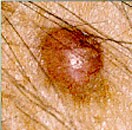 |
 |
 |

Protein Gives Doctors New Tool to Detect Melanoma
Excessive IMP-3, not found in harmless moles, may be key to diagnosis|
|
HealthDay
By Robert Preidt
Wednesday, July 23, 2008
 WEDNESDAY, July 23 (HealthDay News) -- Melanoma produces high levels of a protein called IMP-3, which is not over-expressed in harmless moles, University of Rochester Medical Center researchers report.
WEDNESDAY, July 23 (HealthDay News) -- Melanoma produces high levels of a protein called IMP-3, which is not over-expressed in harmless moles, University of Rochester Medical Center researchers report.
They said the finding may offer doctors a new way to distinguish melanoma -- the most dangerous type of skin cancer -- from benign moles that look like melanoma.
The study was published in the current issue of Modern Pathology.
"We are very excited about our finding that IMP-3 is an important progression marker in malignant melanoma," study author Dr. Jennifer G. Pryor, a third-year resident in the department of pathology and laboratory medicine, said in a university news release.
"Although we have learned a lot about melanoma in recent years, it has unique biologic properties that sometimes make it difficult to diagnose and to plan for the proper treatment. This protein may have a key role in helping us to understand and distinguish between various types of melanocytic lesions," Pryor said.
She and her colleagues analyzed samples of 56 biopsied lesions from 48 adults. None of the benign moles over-expressed IMP-3, but excess levels of the protein were found in most melanomas.
IMP-3, which is involved in cell proliferation, appears to play a role in the formation of number of malignant tumors. Previous studies have linked expression of IMP-3 to pancreatic, ovarian and lung cancers. This new study is the first to identify a connection between the protein and melanoma.
Further research is needed to determine if more careful monitoring and aggressive treatment may benefit melanoma patients with tumors that express IMP-3.
HealthDay
Copyright (c) 2008 ScoutNews, LLC. All rights reserved.
Related News:
More News on this Date
Related MedlinePlus Pages:
| Home | Health Topics | Drugs & Supplements | Encyclopedia | Dictionary | News | Directories | Other Resources | |
| Disclaimers | Copyright | Privacy | Accessibility | Quality Guidelines U.S. National Library of Medicine, 8600 Rockville Pike, Bethesda, MD 20894 National Institutes of Health | Department of Health & Human Services |
Date last updated: 24 July 2008 |




